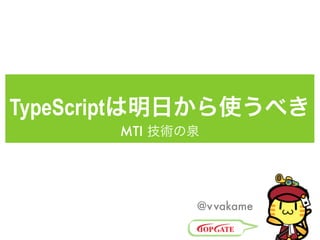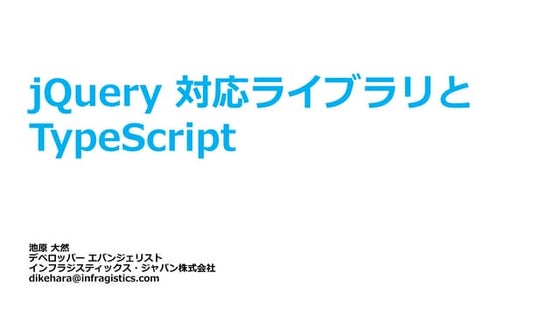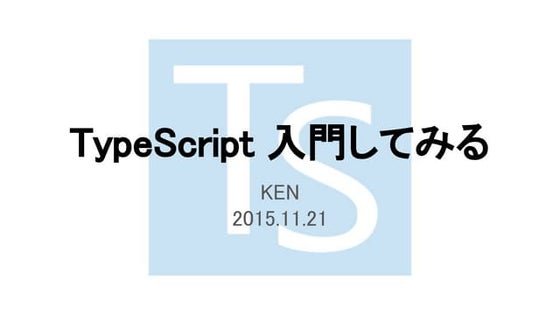Ad
罢测辫别厂肠谤颈辫迟は明日から使うべき
- 1. 罢测辫别厂肠谤颈辫迟は明日から使うべき MTI 技術の泉 @vvakame
- 2. わかめ まさひろ GAE Android @v vakame TypeScript AngularJS
- 3. ? Google App Engine! ? Android! ? Google Apps! などなど、! ! ! 技術に特化した会社です。! Microsoft?
- 5. Type? ? Type = 型! ? 型は多くのプログラミング言語に存在! ? “型”の扱いには言語ごとに優劣がある! ? 静的型付け! ? 動的型付け
- 6. 静的型付け ? 静的解析で多くの整合性検査が可能! ? 不整合があったらコンパイルエラー! ? int hoge = “Hoge”;! ? ↑エラー!! ? 大規模?大人数 になるほど利点?! ? Java?C# などが有名
- 7. 動的型付け ? 型がないわけではないんだけども…! ? 静的に検証しない(できない! ? hoge = “Hi!” ; hoge = 1 ;! ? 問題なし!(ある場合もある! ? テストの重要性? 大人数開発…?! ? Ruby?Python などが有名
- 8. static vs dynamic 一体、どっちがいいの?
- 11. 時代は静的型付けだ! ? 動的型付けの利点は確かにある! ? テスト書きやすい! ? 黒魔術しやすい! ? デメリットもある! ? テストしっかり書かないと死ぬ! ? リファクタリングめっちゃ怖い
- 12. 王者 JavaScript ? 昔はOFFにしとけとか言われてたのに! ? 今や花形ですよ!! ? JavaScript実行しない日があるだろうか! ? いや、ない!
- 13. だがしかし… ? しかしJavaScriptさんはマジガバガバ! ? 動的型付けだしー! ? そんな言語仕様でいいんですか…?! ? クラス無い! ? prototypeとかいうのはある(小声! ? モジュール(パッケージ)無い! ? 安全に開発できない!!!
- 14. そこでTypeScriptですよ ? 静的型付けなJavaScript!! ? クラスある!! ? モジュールある! サイキョーやん?
- 15. 罢测辫别厂肠谤颈辫迟の特长
- 16. 罢测辫别厂肠谤颈辫迟の特长 ? TypeScriptはJavaScriptを拡張した言語! ? 静的型付け!! ? ECMAScript 6規格の文法を先取り☆! ? 読みやすい変換後JavaScript! ? Java, C# とかに優しい言語仕様! ? 長いコンパイル時間 → 1.1.0 で改善 最も現実的なaltJSだ!
- 17. 親Microsoft情報 ? Microsoftが作ってる! ? Visual Studio がサポートしている!! ? C#作者が作ってる! でも僕はMacで使ってる
- 18. Why needs 型? ? 多くのエラーをコンパイル時に! ? 実行時エラーはもううんざり!! ? 間違った使い方は不可能に! ? リファクタリングも安心確実!! ? コンパイルが通ればある程度動く!! ? IDEなどのサポートが得られやすい JS完全互換!
- 19. TypeScriptでの型 ? primitive type 御三家! ? number! ? string! ? boolean JS完全互換!
- 20. TypeScriptでの型 ? 忘れちゃならない! ? any! ? void JS完全互換!
- 21. TypeScriptでの型 ? class! ? 実体も型も存在するイケメン! ? interface! ? 地味 型しか存在しない! ? object type literal! ? ↑TypeScriptリファレンス参照! ? 雑に説明すると即席interface module君も一応いる
- 22. TypeScriptでの型 ? ECMAScriptにいるやつ! ? DateとかArrayとかFunctionとか! ? ブラウザにいるやつ! ? windowとかDOM系のやつとか ↑結局classかinterface
- 24. 型注釈 var str1: string = "string"; var str2: number = "string"; // エラー! var str3 = "string"; // 初期化子の型から型推論されstringを指定したのと等価 str3 = 1; // エラー! ! var b: boolean = true; var n: number = 1; ! var a: any = true; a = 1; // any は何でもOK! http://goo.gl/jKVeHw
- 25. クラス http://goo.gl/l3zjBi class Hoge { name: string; constructor(name: string) { this.name = name; } hello(): string{ return "Hello, " + this.name; } } ! var obj = new Hoge("world"); window.alert(obj.hello());
- 26. インタフェース http://goo.gl/GQD89G interface IHoge { str: string; num: number; } ! var obj: IHoge = { str: "string", num: 1 }; ! window.alert(obj.str + obj.num);
- 27. 内部モジュール http://goo.gl/gvjgTU module sample { export var str = "string"; export class Hoge { hello(word: string): string { return "Hello, " + word; } } } module sample2 { // SampleB.Hoge を Piyoとしてインポート import Piyo = sample.Hoge; export var str = new Piyo().hello("TypeScript"); } window.alert(sample2.str);
- 29. TypeScript & JavaScript ? JSのライブラリが使いたい!! ? jQuery! ? AngularJS! ? mocha! ? etc…! ? お任せください! 既存資産も使う!
- 30. DefinitelyTyped github.com/borisyankov/DefinitelyTyped definitely/déf(?)n?tli/ →define 副詞more ~; most ~ 2 明確に, はっきりと〈断る述べる決めるなど〉. type/ta?p/ 〖語源は「打ってできた形型」〗 (形)typical, (副)typically 名詞複~s/-s/ 1 C(ある特性を共有する)型, タイプ, 類型; 種類(kind2, sort) ウィズダム英和辞典より definitelytyped.org I’m committer!
- 31. 型定義ファイル .d.ts Over 550!
- 32. 既存JSに型を後付けする interface Moment { ! format(format: string): string; format(): string; ! fromNow(withoutSuffix?: boolean): string; ! startOf(soort: string): Moment; endOf(soort: string): Moment; ! add(input: MomentInput): Moment; add(soort: string, aantal: number): Moment; add(duration: Duration): Moment; subtract(input: MomentInput): Moment; subtract(soort: string, aantal: number): Moment; ! calendar(): string; clone(): Moment; ! valueOf(): number; ! local(): Moment; // current date/time in local mode ! utc(): Moment; // current date/time in UTC mode ! isValid(): boolean; http://momentjs.com/ goo.gl/9QnuC3
- 33. 完全網羅! TypeScriptリファレンス 紙?電子共 好評発売中! Amazon(紙, Kindle) 達人出版会(PDF)
- 34. mozaic.fm #5 TypeScript #8 AltJS in LL Diver 2回くらい話した
- 35. 実際の開発風景 見学してみよう!
- 36. 质问?




















































































































